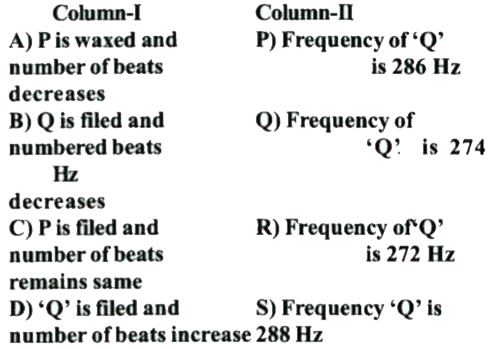Two tuning forks having frequency 256 Hz (A) and 262 Hz (B) tuning fork. A produces some beats per second with unknown tuning fork, same unknown tuning fork produce double beats per second from B tuning fork then the frequency of unknown tuning fork is :-
262
260
250
300
The correct Answer is:C
To solve the problem, we need to find the frequency of the unknown tuning fork (let's denote it as fU). We know the frequencies of the two tuning forks: fA=256Hz and fB=262Hz.
1. Understanding Beats: The number of beats produced when two tuning forks are sounded together is equal to the absolute difference of their frequencies.
Beats=|f1−f2|
2. Beats with Tuning Fork A: When tuning fork A (256 Hz) is played with the unknown tuning fork, let the number of beats produced be n.
n=|256−fU|
3. Beats with Tuning Fork B: When tuning fork B (262 Hz) is played with the unknown tuning fork, it produces double the beats compared to when it was played with tuning fork A. Therefore, the number of beats produced in this case is 2n:
2n=|262−fU|
4. Setting Up the Equations: From the above, we have two equations:
- n=|256−fU|
- 2n=|262−fU|
5. Substituting for n: Substitute n from the first equation into the second:
2|256−fU|=|262−fU|
6. Case Analysis: We need to analyze the absolute values. There are two cases to consider based on the value of fU:
Case 1: fU<256
- Then |256−fU|=256−fU and |262−fU|=262−fU
- The equation becomes:
2(256−fU)=262−fU
Simplifying this gives:
512−2fU=262−fU⟹512−262=fU⟹fU=250Hz
Case 2: 256≤fU<262
- Then |256−fU|=fU−256 and |262−fU|=262−fU
- The equation becomes:
2(fU−256)=262−fU
Simplifying this gives:
2fU−512=262−fU⟹3fU=774⟹fU=258Hz
Case 3: fU≥262 (not applicable since it contradicts the problem statement of producing beats with A and B)
7. Conclusion: The only valid solutions are fU=250Hz and fU=258Hz. However, since the unknown tuning fork produces double beats with B, we conclude that the unknown tuning fork must be 258Hz.
Final Answer:
The frequency of the unknown tuning fork is fU=258Hz.
Beats=|f1−f2|
n=|256−fU|
2n=|262−fU|
- n=|256−fU|
- 2n=|262−fU|
2|256−fU|=|262−fU|
- Then |256−fU|=256−fU and |262−fU|=262−fU
- The equation becomes:
2(256−fU)=262−fU
Simplifying this gives:
512−2fU=262−fU⟹512−262=fU⟹fU=250Hz
- Then |256−fU|=fU−256 and |262−fU|=262−fU
- The equation becomes:
2(fU−256)=262−fU
Simplifying this gives:
2fU−512=262−fU⟹3fU=774⟹fU=258Hz
The frequency of the unknown tuning fork is fU=258Hz.
Topper's Solved these Questions
- BOOK - ALLENCHAPTER - WAVES AND OSCILLATIONSEXERCISE - Part-1(Exercise-02)19videos
WAVES AND OSCILLATIONS
- BOOK - ALLENCHAPTER - WAVES AND OSCILLATIONSEXERCISE - Part-1(Exercise-03)31videos
WAVES AND OSCILLATIONS
- BOOK - ALLENCHAPTER - WAVES AND OSCILLATIONSEXERCISE - Part-3(Example)32videos
WAVES AND OSCILLATIONS
- BOOK - ALLENCHAPTER - SEMICONDUCTORSEXERCISE - Part-3(Exercise-4)51videos
SEMICONDUCTORS
Similar Questions
A tuning fork A produces 5 beats/sec with another tuning fork B of frequency 256 Hz. If tuning fork A produces 1 beats/sec with some other tuning fork C of frequency 250 Hz, then calculate the frequency of fork A.
View SolutionA tuning fork of frequency of 512Hz when sounded with unknown tunning fork produces 5 beats/sec. If arms of the unknown fork are filed then it produces only 3 beats/sec. Find the frequency of unknown tunning fork.
View Solution
Knowledge Check
- Question 1 - Select One
A tuning fork 'P' of frequency 280Hz produces 6 beats/s with unknown tuning fork 'Q'
 AABCDQRSRBABCDQRQPCABCDP.QQ.RR.SPDABCDR.SQ.RSR
AABCDQRSRBABCDQRQPCABCDP.QQ.RR.SPDABCDR.SQ.RSR - Question 2 - Select One
A tuning fork produces 2 beats per second when sounded with another tuning fork of frequency 250 Hz. It gives the same number of beats per second when loaded with wax. The initial frequency of 1st tuning fork is
A252 HzB248 HzC254 HzD246 Hz - Question 3 - Select One
A tuning foork A of frequenct 260 c/s Hz produces 4 beats per second when sounded with a tuning fork B. the number of beats produced per second becomes 3. Then, what is the frequency of tuning fork B?
A264B263C256D260
A tuning fork having n = 300 Hz produces 5 beats/s with another tuning fork. If impurity (wax) is added on the arm of known tuning fork, the number of beats decreases then calculate the frequency of unknown tuning fork.
View SolutionA tuning fork of unknown frequency x, produces 5 beats per second with a tuning fork of frequency of 250 Hz. The produces 10 beats/second with another tuning fork frequency 265 Hz. The unknow frequency is
View SolutionThe prongs of the tuning fork are filled a little, the frequency of the tuning fork after filled
View Solution16 tuning forks are arranged in increasing order of frequency. Any two consecutive tuning forks when sounded together produce 8 beats per second. If the frequency of last tuning fork is twice that of first, the frequency of first tuning fork is :-
View SolutionThe prongs of the tuning fork are filed, then the frequency of the tuning fork after filing will be
View Solution

